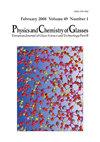致编者信:从网络玻璃的x射线衍射数据中提取原子配位数
IF 0.3
4区 材料科学
Q4 CHEMISTRY, PHYSICAL
Physics and Chemistry of Glasses-European Journal of Glass Science and Technology Part B
Pub Date : 2020-02-21
DOI:10.13036/17533562.61.1.016
引用次数: 0
摘要
结果表明,无论是在实空间还是倒数空间进行拟合,组成原子/离子的详细电子分布和T(r)中的非高斯高斯峰都会严重限制从x射线衍射数据中提取配位数的准确性。然而,一般来说,最好在真实空间中进行拟合,因为在真实空间中,实验峰和拟合峰之间的形状差异要明显得多,而且任何实验不确定性的影响也要明显得多,这可以用第一个真峰下方区域的相关函数中的噪声来表示。还请注意,在互反空间中,非高斯峰形状对正弦包络向零Q的外推的影响,从高Q拟合到干涉函数Qi(Q),同样适用于中子衍射数据,同样限制了所得协调数的准确性。本文章由计算机程序翻译,如有差异,请以英文原文为准。
Letter to the Editor: The extraction of atomic co-ordination numbers from x-ray diffraction data for network glasses
It has been demonstrated that both the detailed electron distributions of the constituent atoms/ions and non-Gaussian Gaussian peaks in T(r) can seriously limit the accuracy of co-ordination numbers extracted from x-ray diffraction data, whether the fit is performed in real or reciprocal space. In general, however, it is preferable to perform the fit in real space, where differences in shape between the experimental and fitted peaks are much more obvious, together with the effect of any experimental uncertainties, as represented by the noise in the resulting correlation function in the region below the first true peak. Note, also, that in reciprocal space the effects of a non-Gaussian peak shape on the extrapolation of the sinusoidal envelope to zero Q, from a high-Q fit to the interference function, Qi(Q), apply equally to neutron diffraction data, similarly limiting the accuracy of the resulting co-ordination numbers.
求助全文
通过发布文献求助,成功后即可免费获取论文全文。
去求助
来源期刊

CiteScore
0.70
自引率
33.30%
发文量
0
审稿时长
1 months
期刊介绍:
Physics and Chemistry of Glasses accepts papers of a more purely scientific interest concerned with glasses and their structure or properties. Thus the subject of a paper will normally determine the journal in which it will be published.
 求助内容:
求助内容: 应助结果提醒方式:
应助结果提醒方式:


